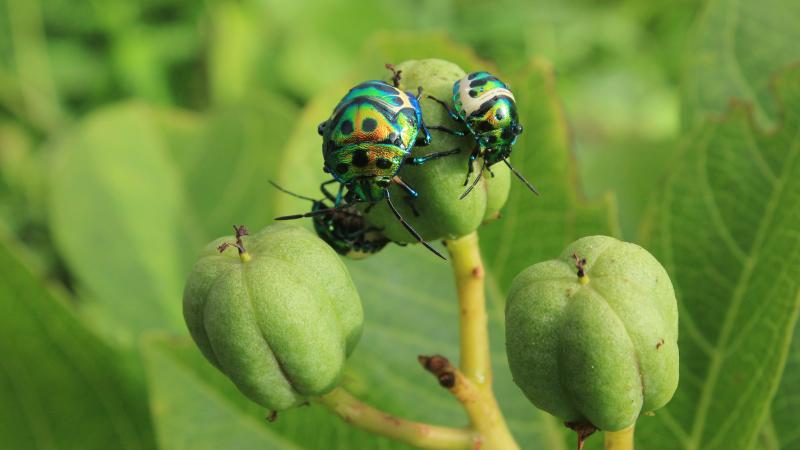
Herbivores have the power to influence and shape the structure and function of plant communities. Certain species of insects complete either a part or the whole of their life cycle only on specific plants. Insects that feed on plants have been known to impact the evolution of leaf size and shape since they have co-evolved with plants for millions of years. Hence, understanding the relationship between the two can help answer questions like why do leaves have such diverse shapes and sizes. A recent study by Mr Ashish Nerlekar from M.E.S. Abasaheb Garware College, Pune, published in the journal Biology Open, has studied the effect of the density of the plant Jatropha nana on the abundance of herbivorous insects.
Jatropha nana or the dwarf jatropha is a threatened tropical perennial herb that was described from Pune in India. It sprouts in May and wilts away until the end of the monsoon. For the rest of the year, the plant remains dormant and survives through its underground tuber. The Vetal hills, Taljai hill, Pashan-Baner hill and NDA hills in Pune are home to the largest population of Jatropha nana in India.
“The dwarf Jatropha is currently found only in a few places and in small numbers and hence, is at risk of extinction. Insects that feed on this plant also alter its population. Therefore, studying insect-plant relationships is very important”, says Mr Nerlekar.
Several theoretical models have been proposed to understand the relationship between the density of host plants and the abundance of herbivorous insects. One such model is the ‘resource concentration hypothesis’, which predicts that specialist herbivorous insects will be more abundant per plant as the density of the host plant increases. This hypothesis has been tested and found to be true in several systems in the natural world. The current study, funded by Idea Wild, USA, attempts to test this hypothesis for Jatropha plants to understand if more Jatropha plants mean one can find more insects (per plant) feeding on them.
The researcher carried out field observations in the hills of Pune at different stages of the host plant’s active life cycle and observed 17 species of insect herbivores including beetles, true bugs, moths and butterflies. All the insect species found feeding on the plant were ‘specialists’, meaning they exclusively feed on plants belonging to the same genus or family as the dwarf jatropha. They also observed an exceptionally high occurrence of the moth Pempelia morosalis feeding on the plant.
So, does the resource concentration hypothesis hold good in the wild tropical system consisting of the Jatropha plants? “My data says both yes and no, and that it depends on several factors like seasonality”, says Mr Nerlekar. The results showed that the ‘more plants mean more insects per plant’ prediction held true only in the initial growing season of the plant. For the remaining season, an opposite pattern was seen—more plants meant fewer insects (per plant) were feeding on them.
The observations of the study point out that such ‘resource dilution effect’, where the resources obtained by an individual decrease as the number of individuals increase, is not uncommon. An earlier, similar study assessed the implications of the resource dilution effect and found that this phenomenon may be more widespread than previously thought. This finding could mean that the extent to which the impact of resource concentration occurs in nature need to be re-assessed.
This study brings to light the lesser known Jatropha plants, which are listed as vulnerable as per the IUCN assessments and could soon go extinct due to rampant afforestation activities around Pune. Many organizations and nature enthusiasts plant trees to make the hills greener, which unfortunately changes the landscape from an open, mixed tree-grass system to wooded forest. These changes threaten to wipe out not just the Jatropha plants and the insects which depend on them but also other existing, local biodiversity.
The study is one of the few that collects empirical data on the insect-plant relationship in the tropics. “Despite the recent theoretical models proposed for understanding the relationship between host plant density and insect herbivore loads, empirical evidence for these models from wild tropical systems is currently limited. This work highlights patterns for one such wild, dwarf herb in a seasonally dry urban savanna. I hope that similar research will be initiated on tropical wild plants belonging to various functional groups and in different biogeographic zones to validate the proposed models”, signs off Mr Nerlekar.





